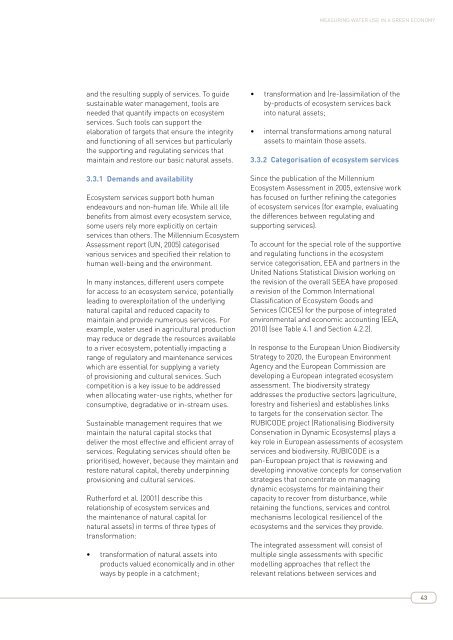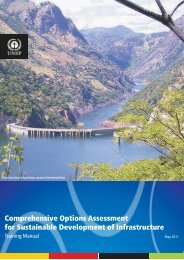MEASURING WATER USE IN A GREEN ECONOMY - UNEP
MEASURING WATER USE IN A GREEN ECONOMY - UNEP
MEASURING WATER USE IN A GREEN ECONOMY - UNEP
You also want an ePaper? Increase the reach of your titles
YUMPU automatically turns print PDFs into web optimized ePapers that Google loves.
Measuring water use in a green economy<br />
and the resulting supply of services. To guide<br />
sustainable water management, tools are<br />
needed that quantify impacts on ecosystem<br />
services. Such tools can support the<br />
elaboration of targets that ensure the integrity<br />
and functioning of all services but particularly<br />
the supporting and regulating services that<br />
maintain and restore our basic natural assets.<br />
3.3.1 Demands and availability<br />
Ecosystem services support both human<br />
endeavours and non-human life. While all life<br />
benefits from almost every ecosystem service,<br />
some users rely more explicitly on certain<br />
services than others. The Millennium Ecosystem<br />
Assessment report (UN, 2005) categorised<br />
various services and specified their relation to<br />
human well-being and the environment.<br />
In many instances, different users compete<br />
for access to an ecosystem service, potentially<br />
leading to overexploitation of the underlying<br />
natural capital and reduced capacity to<br />
maintain and provide numerous services. For<br />
example, water used in agricultural production<br />
may reduce or degrade the resources available<br />
to a river ecosystem, potentially impacting a<br />
range of regulatory and maintenance services<br />
which are essential for supplying a variety<br />
of provisioning and cultural services. Such<br />
competition is a key issue to be addressed<br />
when allocating water-use rights, whether for<br />
consumptive, degradative or in-stream uses.<br />
Sustainable management requires that we<br />
maintain the natural capital stocks that<br />
deliver the most effective and efficient array of<br />
services. Regulating services should often be<br />
prioritised, however, because they maintain and<br />
restore natural capital, thereby underpinning<br />
provisioning and cultural services.<br />
Rutherford et al. (2001) describe this<br />
relationship of ecosystem services and<br />
the maintenance of natural capital (or<br />
natural assets) in terms of three types of<br />
transformation:<br />
• transformation of natural assets into<br />
products valued economically and in other<br />
ways by people in a catchment;<br />
• transformation and (re-)assimilation of the<br />
by-products of ecosystem services back<br />
into natural assets;<br />
• internal transformations among natural<br />
assets to maintain those assets.<br />
3.3.2 Categorisation of ecosystem services<br />
Since the publication of the Millennium<br />
Ecosystem Assessment in 2005, extensive work<br />
has focused on further refining the categories<br />
of ecosystem services (for example, evaluating<br />
the differences between regulating and<br />
supporting services).<br />
To account for the special role of the supportive<br />
and regulating functions in the ecosystem<br />
service categorisation, EEA and partners in the<br />
United Nations Statistical Division working on<br />
the revision of the overall SEEA have proposed<br />
a revision of the Common International<br />
Classification of Ecosystem Goods and<br />
Services (CICES) for the purpose of integrated<br />
environmental and economic accounting (EEA,<br />
2010) (see Table 4.1 and Section 4.2.2).<br />
In response to the European Union Biodiversity<br />
Strategy to 2020, the European Environment<br />
Agency and the European Commission are<br />
developing a European integrated ecosystem<br />
assessment. The biodiversity strategy<br />
addresses the productive sectors (agriculture,<br />
forestry and fisheries) and establishes links<br />
to targets for the conservation sector. The<br />
RUBICODE project (Rationalising Biodiversity<br />
Conservation in Dynamic Ecosystems) plays a<br />
key role in European assessments of ecosystem<br />
services and biodiversity. RUBICODE is a<br />
pan-European project that is reviewing and<br />
developing innovative concepts for conservation<br />
strategies that concentrate on managing<br />
dynamic ecosystems for maintaining their<br />
capacity to recover from disturbance, while<br />
retaining the functions, services and control<br />
mechanisms (ecological resilience) of the<br />
ecosystems and the services they provide.<br />
The integrated assessment will consist of<br />
multiple single assessments with specific<br />
modelling approaches that reflect the<br />
relevant relations between services and<br />
43

















